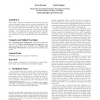223 search results - page 3 / 45 » Types, Maps and Separation Logic |
FUZZIEEE
2007
IEEE
14 years 1 months ago
2007
IEEE
— In this paper, we propose two novel indices for type-2 fuzzy rule ranking to identify the most influential fuzzy rules in designing type-2 fuzzy logic systems, and name them a...
APSEC
2008
IEEE
14 years 2 months ago
2008
IEEE
Memory usage analysis is an important problem for resource-constrained mobile devices, especially under mission- or safety-critical circumstances. Program codes running on or bein...
ESANN
2001
13 years 9 months ago
2001
Networks estimating probability density are usually based on radial basis function of the same type. Feature Space Mapping constructive network based on separable functions, optimi...
TLDI
2003
ACM
14 years 24 days ago
2003
ACM
We develop a logic for reasoning about adjacency and separation of memory blocks, as well as aliasing of pointers. We provide a memory model for our logic and present a sound set ...
CAV
2004
Springer
14 years 29 days ago
2004
Springer
Abstract. Separation Logic consists of a Boolean combination of predicates of the form vi ≥ vj +c where c is a constant and vi, vj are variables of some ordered infinite type li...

